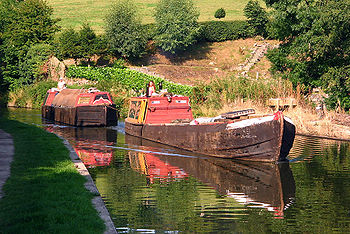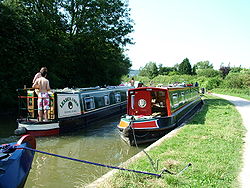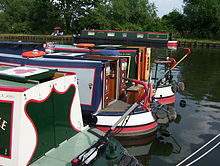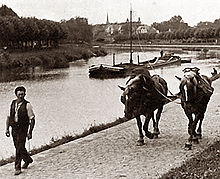- Narrowboat
-
A narrowboat or narrow boat is a boat of a distinctive design, made to fit the narrow canals of Great Britain.
In the context of British Inland Waterways, "narrow boat" refers to the original working boats built in the 18th, 19th, and 20th centuries for carrying goods on the narrow canals (where locks and bridge holes would have a minimum width of 7 feet (2.1 m)). The term is extended to modern "narrowboats" used for recreation and occasionally as homes, whose design is an interpretation of the old boats for modern purposes and modern materials.
Contents
Terminology
Purists tend to use the term with a space (narrow boat) when referring to an original boat or a replica, and to omit the space when referring to a modern boat used for leisure or as a residence - but this is not a hard and fast rule.[citation needed] The single word 'narrowboat' has been adopted by authorities such as British Waterways and the magazine Waterways World to refer to all boats built in the style and tradition of the narrow canal locks.
Although some narrow boats were built to a design based on river barges, it is incorrect to refer to a narrowboat (or narrow boat) as a barge. In the context of the British inland waterways, a barge is usually a much wider, cargo-carrying boat or a modern boat modelled on one, certainly more than 7 feet (2.1 m) wide.
It is also incorrect (or at least incongruous) to refer to a narrowboat as a longboat, although this name was sometimes used in the Midlands in working-boat days.
Usage has not quite settled down as regards (a) boats based on narrowboat design, but too wide for narrow canals; or (b) boats the same width as narrowboats but based on other types of boat.
Size
The key distinguishing feature of a narrowboat is its width: it must be no more than 7 feet (2.13 m) wide to navigate the British narrow canals. Some old boats are very close to this limit (often built 7 feet 11⁄2 inches/2.17 metres or slightly wider), and can have trouble using locks that are not quite as wide as they should be because of subsidence. Modern boats are usually 6 feet 10 inches (2.08 m) wide to guarantee easy passage everywhere.
Because of their slenderness, some narrowboats seem very long. The maximum length is about 70 feet (21 m), the length of most locks on the narrow canals. However, modern narrowboats tend to be shorter than this, so that they can cruise anywhere on the connected network of British canals - including on the "wide" canals (built for wider, but shorter, boats). The shortest lock on the main network is Salterhebble Middle Lock on the Calder and Hebble Navigation, at about 56 feet (17 m) long. However, the C&H is a wide canal, so the lock is about 14 feet 2 inches (4.32 m) wide. This makes the largest "go-anywhere-on-the-network" narrowboat slightly longer (about 60 feet) than the straight length of the lock, because it can (with a certain amount of "shoehorning") lie diagonally. Some locks on isolated waterways are as short as 40 feet (12.2 m).
Hire fleets on British canals can contain narrowboats of many lengths from about 30 feet (9.1 m) upwards, to allow parties of different sizes or different budgets to hire a boat.
Development - traditional working boats
The first working narrow boats played a key part in the economic changes accompanying the British Industrial Revolution. They were wooden boats drawn by a horse walking on the canal towpath led by a crew member, often a child. Narrowboats were chiefly designed for carrying cargo, though there were some packet boats, carrying passengers, letters, and parcels.
Boatmen's families originally lived ashore, but in the 1830s as canals started to feel competition from the new railways, families (especially of owner/skippers of independent single boats) started to take up home afloat. This was partly because they could no longer afford rents, partly to provide extra hands to work the boats harder, faster and further, and partly to keep families together. However, as late as 1858, a "Household Words" article states that the Grand Junction Canal company did not allow the boatmen's families on board – and the crew of the non-stopping ("fly") boat in the article (the skipper, two crewmen, and a 'youth') is said to be typical.
 Historic working narrowboats on the Macclesfield Canal in Cheshire, England. The motor boat at the front "Forget Me Not" is pulling along an unpowered butty "Lilith". This was the traditional working style used on working boats after motor boats became common.
Historic working narrowboats on the Macclesfield Canal in Cheshire, England. The motor boat at the front "Forget Me Not" is pulling along an unpowered butty "Lilith". This was the traditional working style used on working boats after motor boats became common.
The rear portion of the boat became the cosy "boatman's cabin", familiar from picture postcards and museums, famous for its space-saving ingenuity and for its interior made attractive by a warm stove, a steaming kettle, gleaming brass, fancy lace, painted housewares, and decorated plates. Although such descriptions rarely consider the actual comfort of a large family working an extremely hard and long day, and sleeping in the one tiny cabin, it is no doubt true that at the time there were many workers in harder, indoor, trades with less healthy conditions and worse accommodation where the family were separated for long hours rather than being together all day. Nonetheless it was impossible for such mobile families to send their children to school, and most boat people remained illiterate and ostracised by those living 'on the bank'.
As diesel and steam replaced the tow horse in the early twentieth century, it became possible to move more cargo with the same manpower by towing a second unpowered boat, commonly referred to as a "butty", "buttyboat" or "butty boat". There was now no horse to look after, but someone had to steer the butty, unless on a wide canal such as the Grand Union Canal where the two boats could be roped side-to-side or 'breasted up', and handled as one while working locks.
Cargo-carrying by narrow boat was almost extinguished as a way of life between 1945 and the last regular long distance traffic finished in 1970. However some traffic continued into the 1980s and beyond including over 2 million tonnes of aggregate carried on the Grand Union (River Soar) from 1976 to 1996, latterly using wide beam barges however, and aggregate currently carried by narrow boats (and wide barges) between Denham and West Drayton on the Grand Union Canal. A few people are doing their best to keep the tradition alive, mostly by "one-off" deliveries rather than regular runs, or by selling goods such as coal to other boaters.
There are many enthusiasts dedicated to restoring the remaining old boats, often members of the Historic Narrow Boat owners Club [1] and there are also many replicas ornately painted with the same traditional designs, usually of roses and castles. If the boat is not horse-drawn, it may have a refurbished, slow-revving, vintage diesel engine, and there are even some steam-driven narrow boats such as the ex-Fellows Morton and Clayton steamer President.[2]
Painted decoration on narrowboats
By the latter part of the 19th century it was common practice to paint roses and castles on both narrow boats themselves and their fixtures and fittings. Common sites include the doors to the cabin, the water can or barrel and the side of the boat along with ornate lettering giving the boat's name and owner.
The origin of the roses and castles found on canal boats is unclear. The first written reference to them appears to be in an 1858 edition of the magazine Household Words in one of a series of articles titled "On the Canal" but while this shows that the art form must have existed by this date it doesn't provide us with an origin. For some time, a popular suggestion was that it had some form of Gypsy origin, however there does not appear to be a significant link between the Gypsy and boating communities. Other suggestions include transfer of styles from the clock-making industry (in particular the decoration on the face), the japanning industry or the pottery industry. There is certainly a similarity in style and a geographical overlap, but no solid proof of a link. There are similar styles of folk art in Scandinavia, Germany, Turkey and Bangladesh.
In the eighteenth century, the similar Dutch "Hinderloopen" paintwork would only have been a sailing barge journey away from the Thames. There is also an article in the Midland Daily Telegraph of 22 July 1914 that credits the practice painting of water cans, at least, to a Mr Arthur Atkins. The date of the events make the claim possible, but would require the Household Words article to be reporting on the very start of a phenomenon, rather than – as its tone suggests – something that had existed for some time. Until further evidence comes to light, it is impossible to support or deny the claim that Arthur Atkins was responsible for the start of the practice and thus the origin of the paintings remains uncertain.
While the practice declined as commercial use of the canals dwindled, it has seen something of a revival in recent times with the emergence of leisure boating. Narrowboat decoration with roses and castle themes are a reasonably common sight on today's canals, although these may utilise cheaper computer-printed vinyl transfers in place of the traditional craft of hand-painted designs.
Modern narrowboats
 Modern narrowboats on the Kennet and Avon Canal
Modern narrowboats on the Kennet and Avon Canal
The number of licensed boats on canals and rivers managed by British Waterways (BW), a government organisation, was estimated at about 27,000 in 2006. There are perhaps another 5,000 unlicensed boats kept in private moorings or on other waterways.[3] Most of the boats on BW waterways are steel cruisers popularly referred to as narrowboats.
Modern narrowboats are used for annual holidays, weekend breaks or as permanent residences. Usually, they have steel hulls and a steel superstructure, but when they were first being developed for leisure use in the 1970s glass re-inforced plastic (fibre-glass) or timber was often used for the superstructures. They are usually powered by modern diesel engines, and are fitted inside to a high standard. There will be at least 6 feet (1.8 m) internal headroom, and similar domestic facilities as a small landward home: central heating, flush toilets, shower or even bath, four-ring hobs, oven, grill, microwave oven, and refrigerator; quite a few also have satellite television and mobile broadband via the use of 3G broadband technology. Externally, their resemblance to traditional boats can vary from a faithful imitation (false "rivets", and copies of traditional paintwork) through "interpretation" (clean lines and simplified paintwork) through to a free-style approach which does not try to pretend in any way that this is a traditional boat.
They are owned by individuals, shared by a group of friends (or by a more formally organised syndicate), rented out by holiday firms, or used as cruising hotels. A few boats are lived on permanently: either based in one place (though long-term moorings for residential narrowboats are currently very difficult to find) or continuously moving around the network (perhaps with a fixed location for the coldest months, when many stretches of canal are closed by repair works or "stoppages").
Modern narrowboat types
On most narrowboats steering is by a tiller, as it was on all working narrow boats, and the steerer stands at the stern of the boat, aft of where a person emerges from the hatchway and rear doors at the top of the steps up from the cabin. The steering area comes in three basic types, each meeting different needs in terms of maximising internal space; having a more traditional appearance; having a big enough rear deck for everyone to enjoy summer weather or long evenings; or protection for the steerer in bad weather. Each type has its strong advocates. However, the boundaries are not fixed, and some boats blur the categories as designers try out slightly different arrangements and combinations.
Narrowboats with traditional stern
 Traditional-stern narrowboats at Saul, Gloucestershire
Traditional-stern narrowboats at Saul, Gloucestershire
Many modern canal boats retain the traditional layout of a small open, unguarded "counter" or deck behind the rear doors from which the crew can step onto land. It is possible to steer from the counter, but this is not very safe, with the propeller churning below only one misstep away. The length of the "tiller extension" allows the steerer to stand more safely on the top step, forward of the rear doors (on a working boat, this step would have been over the top of the coal box). On cold days, the steerer can even close the rear doors behind them, and be in relative comfort, their lower body in the warmth of the cabin, and only their upper body emerging from the hatchway and exposed to the elements. In good weather, many trad-stern steerers sit up on the hatchway edge, a high vantage point giving good all-round visibility. On trad boats, the bow "well-deck" forms the main outside viewing area, because the traditional stern is not large enough for anyone other than the steerer to stand on safely.
Narrowboats with cruiser stern
 Cruiser-stern narrowboat at Tardebigge
Cruiser-stern narrowboat at Tardebigge
Cruiser stern narrowboats are designed to allow more people to be on deck during the reasonably good weather of the British summer holiday season. The hatch and rear doors are farther forward than on a traditional boat, creating a large open deck between counter and rear doors, protected by a rail (perhaps with seats) around the back and sides. At the rear, a "cruiser" narrowboat looks very different from traditional boats. The large rear deck provides a good social space or al fresco dining area, but in the winter (or the occasionally less than perfect weather of the British Summer) the steerer is quite unprotected from wind and rain. The lack of an enclosed engine room means that engine heat does not contribute to keeping the boat warm and there is wasted space above the deck area. The name for this style arises because the large open rear deck resembles that of the large rear cockpits common on glass-fibre (Glass-reinforced plastic or GRP) river cruisers. The "cruiser" stern also allows the engine to be located under the deck and not in the cabin as it is in a traditional-stern boat. Although this then makes access to the engine for maintenance more difficult,[citation needed] it does have the advantage that the engine is not located in the cabin and the ensuing noise and smell are not as much of an issue.
Narrowboats with semi-traditional stern
A semi-traditional stern is a compromise to gain some of the "social" benefits of a cruiser stern, while retaining a more traditional design and providing some protection for the steerer in bad weather or in cooler seasons. As with the cruiser stern, the deck is extended back from the hatch and rear doors, but in this case most of the deck is protected at the sides by walls which extend back from the cabin sides – giving a more sheltered area for the steerer and companions, usually with lockers to sit on. The engine is located under the deck, much like a cruiser, again allowing a separation between the cabin and the engine bay, with the steps down to the cabin being located past the false sides of the "semi-trad" social area.
Narrowboats with a butty stern
A butty boat is an un-powered boat traditionally with a larger rudder with (usually) a wooden tiller (known as an elum, a corruption of helm[4]) as the steering does not benefit from the force of water generated by the propeller. The tiller is usually removed and reversed in the rudder-post socket to get it out of the way when moored. A few butty boats have been converted into powered narrowboats like NB Sirius. The term butty is derived from a dialect word meaning companion.[5]
Centre cockpit narrowboats
A small number of steel narrowboats dispense with the need for a rear steering deck entirely, by imitating some river cruisers in providing wheel steering from a central cockpit.
National organisations
- Inland Waterways Association - campaigns for the use, maintenance, and restoration of Britain's inland waterways
- National Association of Boat Owners (NABO) - 3,000 members in 2004. They publish one of the only in-print books about living aboard a narrowboat, Living Afloat (2005). See also 'Living Aboard', The History Press (2008).
- National Community Boats Association - a federation of organisations running narrow and other boats on navigable waterways for the benefit of the community.
- Residential Boat Owners' Association
See also
- Canals of Great Britain
- History of the British canal system
- Continuous cruiser
- Pleasure craft
- Cabin cruiser
- Houseboat
References
- ^ Historic Narrow Boat owners Club
- ^ "Steam narrow boat President". 'Friends of President' website. http://www.nb-president.org.uk. Retrieved 2007-10-28.
- ^ Boating : British Waterways
- ^ Woolfitt, Susan (1947). Idle Women. London: Benn. p. 59. OCLC 14967671.
- ^ Second edition, 1989; online version June 2011. <http://www.oed.com/view/Entry/25457>; accessed 10 August 2011. Earlier version first published in New English Dictionary, 1888.
External links
- historic Narrow Boat Owners Club encourage the preservation, restoration and use of working and ex-working narrow boats.
- Narrow Boat Trust preserves and restores narrow boats for the benefit of the public
- National Waterways Museum The largest museum dedicated to our waterways, at Ellesmere Port
- London Canal Museum London's waterways museum, with a narrowboat and cabin to explore.
- Residential Boat Owners' Association — "exists to act in and to further the interests of boat dwellers on the coasts, rivers and canals of Britain"
- Narrowboatworld.com — a non-commercial enthusiast site.
- Canal Folk Art A series of articles covering Canal Art Roots, Roses and Castles, Narrowboat Signwriting, Traditional Canalboat Decorations, Boat Painters etc.
- Wild over Water Website for children to learn more about waterways, boats and water safety.
- British Waterways website - corporate information, document downloads, licencing, Waterfront magazine
- Waterscape.com - British Waterways leisure website - wildlife, cycling, walking, boating, maps
- Association of Inland Navigation Authorities (AINA)
- Narrow Boat Design - General information on narrow boats
Modern merchant ships Dry cargo Tankers Passenger Cargo liner · Cruiseferry · Cruise ship · Ferry · Narrowboat · Ocean liner · RORO ship · Train ferrySupport Other Pipe-laying ship · Cable layer · Crane vessel · Dredger · Drillship · Fishing vessel · Icebreaker · Merchant submarine · Narco submarine · Research vessel · Riverboat · Semi-submersible · SnagboatCategories:- Boat types
- Houseboats
- Canals in the United Kingdom
Wikimedia Foundation. 2010.



